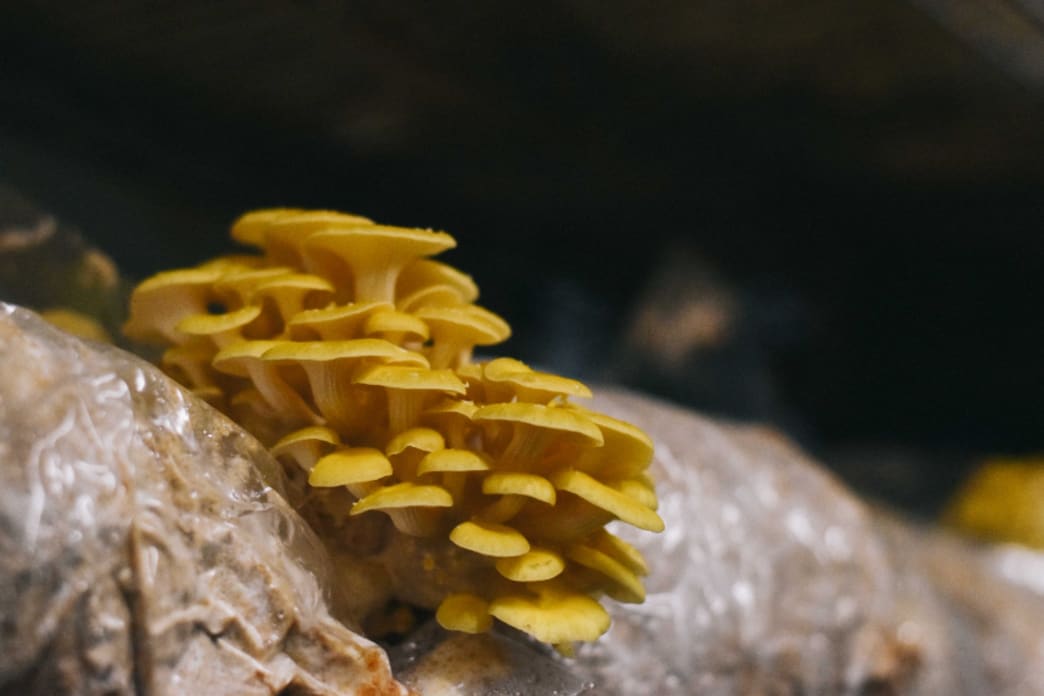This article shares tips on preparing supplement sawdust blocks for growing oyster mushrooms commercially indoors. Learn about this process now
Indoor mushroom production on supplemented sawdust blocks, which we will also commonly refer to as “blocks'' in this article, is a popular method for specialty mushroom production. Growing oyster mushrooms commercially on supplemented sawdust blocks allows for fast cropping cycles with high yields.
Indoor block production allows for precise environmental controls and year-round production. This method also means that management of the crop intensifies, and costs like rent, infrastructure, and materials increase. If a farm is being developed as a large-scale mushroom farm, it makes sense to produce mushrooms using this method.
Indoor fruiting typically means creating an environment inside of another building or existing structure that will be ideal for mushrooms to fruit in. Basements of houses, barns, trailers, and warehouses are all viable options for indoor mushroom fruiting. One major advantage of indoor fruiting is the flow of production. A farm can be designed to include handling/treatment, lab, incubation, fruiting, storage and shipping areas all in a single building. On a large scale producing over 300 pounds per week, this becomes critical. On a small scale little inefficiencies can be annoying but won’t make or break the operation as it would in larger scales.
Growing oyster mushroom commercially: There are three options you can explore to procure sawdust blocks:
- Create a lab and produce the blocks in-house. This does require a considerable amount of space, up-front cost, and training. However, it can be profitable for you.
- Purchase the blocks new from another company or local mushroom farm. Take the lab work out of it and start by buying the blocks. Doing so in bulk can make it a profitable option, especially with a walk-in cooler. A walk-in cooler and cash flow of about $7,000 is needed for growing about 150 pounds per week.
- Purchase second-flush blocks from a local mushroom farm. Second-flush blocks are cheaper than new blocks and are sometimes sold by the truckload for $1 per block. Yields will be much lower and sporadic, but this is a great method for growing mushrooms if cash flow is an issue. Another benefit to this is that over the course of one year these blocks will turn into incredible soil, so there is both an investment in the mushrooms as well as building organic matter and soil for your farm.
Preparing your substrate for growing oyster mushrooms commercially with supplemented sawdust blocks
growing oyster mushrooms commercially - Sourcing sawdust: This is a process of getting to know your local economy and local agricultural products. Finding a local sawmill that cuts exclusively oak, or who will call you when they mill oak, is best. Flooring mills tend to be extremely consistent and a great source of sawdust for mushroom farms. Be sure that the mill knows not to mix in other types of sawdust. You may be able to get sawdust at a cost of $10/yard when delivered in 30-yard batches.
For supplementation, wheat bran and gypsum can be easily sourced from local feed stores. Wheat middlings are often available from animal feed companies and can be purchased in bulk and stored in silos to get extremely cheap pricing. Both wheat bran and mids can be used as a supplement. Wheat mids generally have more variables and contain germ, bran and sometimes flour all in one. It is best to get the nutritional analysis of this from whoever you are looking to purchase substrate from.
Growing oyster mushrooms commercially - Mixing the substrate: The best option for any mushroom farm growing more than 150 pounds of mushrooms a week is a ribbon mixer. This is a piece of equipment designed for the potting soil industry but works great for mixing mushroom substrate. Substrate is loaded into the mixer and wet during the mixing process.
For more handy and industrious mushroom growers, homemade dry mixers are being developed. This allows the process of mixing and bagging to be combined into one step with sawdust and supplements added dry and then water added individually to each bag. This can all be done using a scale and flow meter to measure the exact amounts of substrate and water desired in each bag. When mixing, it is better for the substrate to be slightly dry than too wet. When it is too wet, substrate sticks to the bag, which then becomes extremely difficult to seal. Aiming for a moisture content around 55-60% is ideal. At Fungi Ally, this was measured by the “squeeze test” to see if the substrate holds shape but does not drip any water.
Growing oyster mushrooms commercially - Bagging the substrate: Bagging is one of the more time-consuming and repetitive tasks. Bagging and folding is a great example of a seemingly trivial unimportant task having a big impact on the overall success of cultivation. If the area where the bag will be sealed is not clean and well folded, it becomes very difficult to seal. If it is folded with a wrinkle in it, sealing becomes difficult.
When folding by hand, the bag should be folded so the filter is on the inside. This ensures the filter does not get wet, allowing for growth of organisms through the filter. Ensure the fold has no creases in it, which will make for difficult sealing later in the process.
Note: It is not recommended to fruit oyster mushroom blocks outside because they get larvae in them when grown outside.

